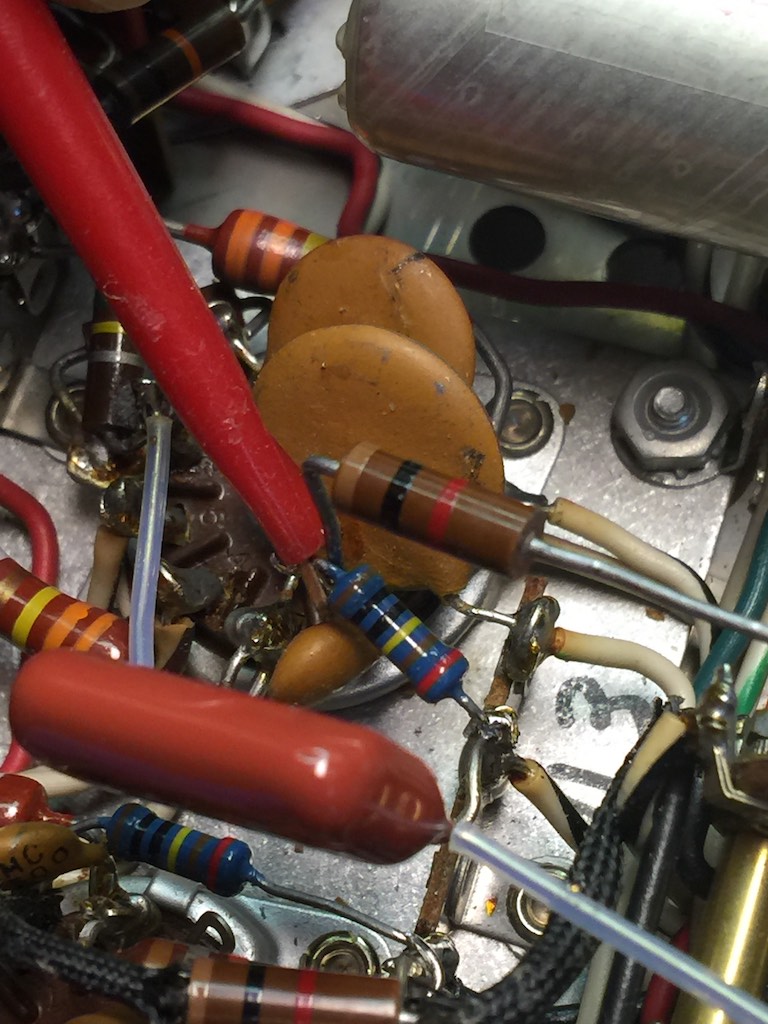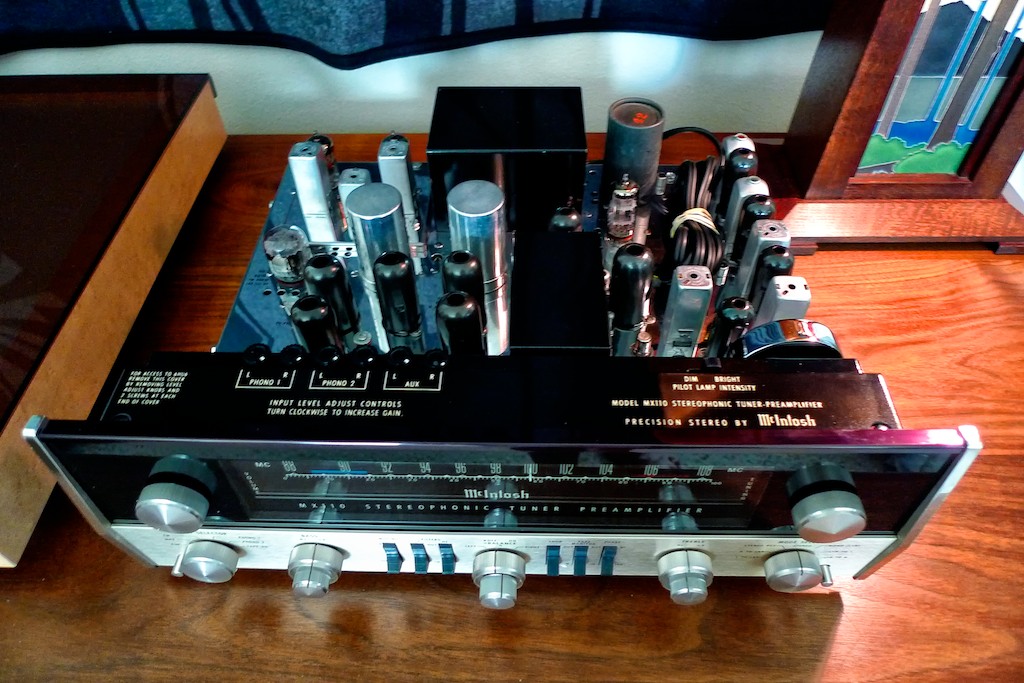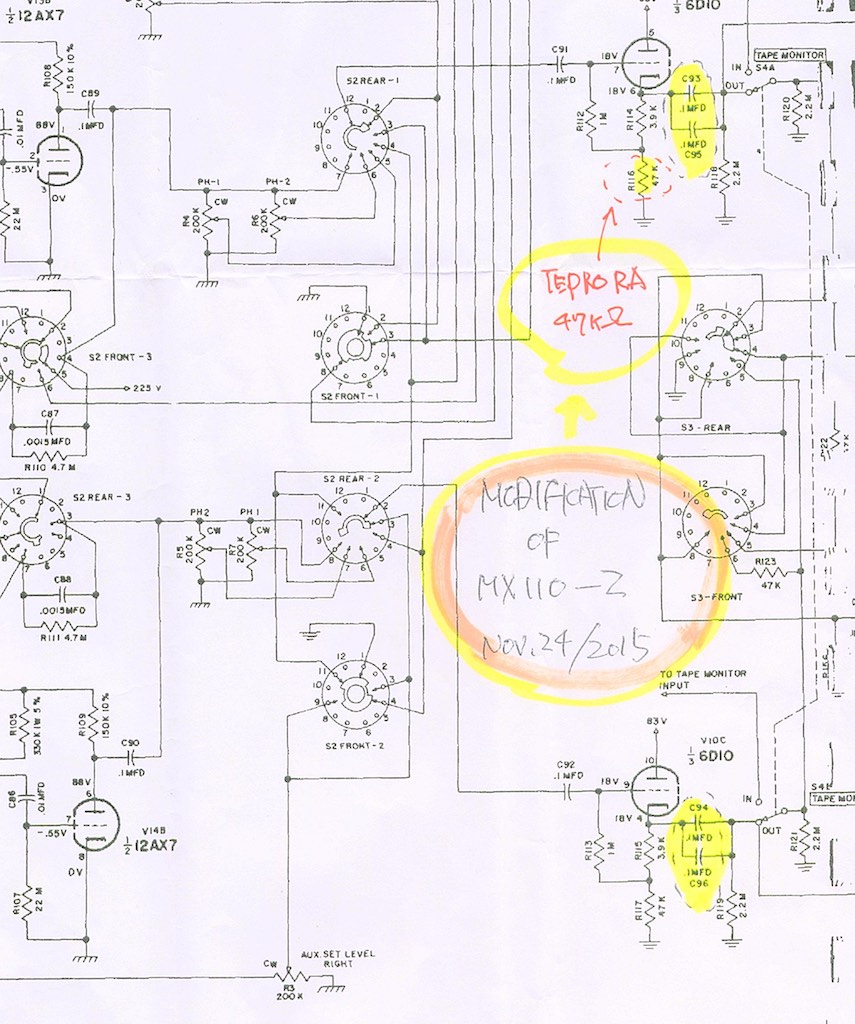Yazaki-san, Ron-san, and I, buoyed by our dramatic success with our Real Sound adventure with my vintage McIntosh MC30 monaural amplifiers (below), embarked on another Real Sound adventure with my vintage McIntosh MX110 tuner-preamplifier, as I have reported on earlier in several posts.
Well how do I say this? Things haven't gone so well with our Real Sound MX110 adventure, and as of yet we haven't figured out quite why, but we're working on it, and moving forward in small steps.
One of the things about real-time blogging on the internet is that it is very transparent. When something works well and I really like it, you'll see me wax enthusiastically about the results as soon as it happens, like I did with the amazing Duelund CAST crossovers project that Frederik & I did for my Westminsters, or the remarkable Western Electric WE16GA wire from Yazaki-san, to cite a couple of examples.
When things don't work out so well you can also expect the same sort of transparency from me. That can be a bit more awkward for those involved, but I think it's equally important, as it keeps things 'real' with respect to results, and you don't have to wonder if you're getting a candy-coated version of what's happening here at Jeff's Place.
A case in point: After Ron, Leo, and I had listened to the three modified vintage McIntosh MX110 tuner preamplifiers, it was clear that while there were some real positive sonic aspects to the modifications we had performed, overall the experiment was not a success, and all three of the modified MX110s sounded much worse than my 'stock' restored MX110Z that I had bought from the vintage McIntosh specialist team of Tom Manley & Terry DeWick at McIntosh Home Audio & DeWick Repairs.
In fact, the modified MX110s sounded so much worse than my stock unit they were almost unlistenable. This was particularly true on female vocals, which sounded very forward, edgy, and shouty, and listening for more than a few moments was quite unpleasant. My MX110 was the worst sounding of the three, Georges's was a little better sounding, and Leo's was a little better still, but still you wouldn't have wanted to listen to any of them for very long.
As a reminder, here's the modifications we implemented for the MX110s:
Modification A: We replaced the stock 56KΩ phono stage input resistors at R88 & R90 (left inputs) and R89 & R91 (right inputs), for phono input #1 and phono input #2 with Tepro RA 47KΩ metal film resistors. The phono stage’s sound quality depends mainly on these resistors.
Modification B: We modified the first stage cathode follower of the high level input by replacing two key pairs of 0.1uF capacitors at C93 & C95 and C94 & C96 with a pair of 0.22 uF Arizona Capacitors.
Modification C: We did four modifications to the power supply. First we replaced the stock 47KΩ cathode resistors at R116 & R117 with Tepro RA 47KΩ metal film resistors (above). These cathode resistors have a large influence on the the sound quality because the signal current flows through them.
Next we added in the C1, C2, and C3 modifications (below).
In the C1 modification we added a SPEC Ruby-Mica capacitor (MC103DA, 0.01μF / 500VDC ) to the circuit. Yazaki-san said, "Bridge rectifier circuit has good efficiency but diode’s switching noise level and distribution might be higher or wider than half-wave or full-wave rectification. And mica capacitor’s outstanding performance for high frequency could allow these noise to be able to terminate to the ground. I hope some effects would be promising. By the way, the Marantz Model 7’s plate power supply adopted half wave rectification. I imagine it would be one of the secrets of the sound of the Model 7.”
In C2 & C3 we added 0.22μF / 600VDC Arizona Capacitor capacitors to strengthen the power supply. Yazaki-san said this modification was to “strengthen or lower impedance of the plate power supply. Please select by Jeff-san’s inspiration . Because that each color cap could improve the sound, but If you like Red 0.22 for C93-C96, I would like to suggest you to use Blue or Green. Red with Blue or Red with Green could compensate the character of Red.”
Ok, so that's what we did for modifications to the MX110. So what went wrong?
Eagle-eyed reader, Gareth, had postulated that it was switching from 56KΩ to 47KΩ resistors on the phono inputs that was the culprit, and I had wondered about that myself. The difficulty we faced was that there were no Tepro RA 56KΩ resistors to be had for now, so we would have to wait a couple of months before we could get our hands on some to try. Clearly waiting for a couple of months for 56KΩ Tepro resistors was not an option for me, as I couldn't just mothball my main reference system for a couple of months.
I conferred with Yazaki-san about what we were hearing and what we might do about it. He told me, "I checked the circuit diagram of the first stage of phono EQ of Marantz Model 7 and also McIntosh C22. They use the phono input resistor, 47kΩ and the grid resistor, 1MΩ for 12AX7. And the combined resistance is around 44.9kΩ. But MX110, the phono input resistor, 56kΩ and grid resistor, 220kΩ. And also the resistance is 44.6kΩ. When we installed 47kΩ into MX110, the combined resistance is 38.7kΩ. I suppose you have been using MC transformer and the combination of your MC transformer and the input resistor, 47kΩ would be some harmful effect on the tonal character. And so, I have a idea that, how would be changing the resistor R94 & R95 from 220kΩ to 1MΩ ... And I suppose there would not be any negative effects about this changing."
Ron-san had a couple of suitable 1MΩ resistors, so he changed R94 & R95 from 220kΩ to 1MΩ resistors as Yazaki-san suggested.

You can see the blue 1MΩ resistors Ron installed at R94 & R95 . The red pointer is on one towards the middle of the photo, and you can see the other in the lower left of the photo.
There was some small improvement by going to 1MΩ resistors at R94 & R95, but unfortunately the MX110s were still essentially unlistenable.
Ron-san to the rescue: Ron had a number of NOS ¼ watt 9KΩ Roederstein resistors manufactured prior to 1993 when Vishay had purchased the company, and so he installed a pair of those in series with the Tepro RA 47KΩ resistors on phono input 1, bringing the total resistance on input 1 back to 56KΩ, while leaving phono input 2 at 47KΩ as a control.
Going back to 56KΩ resulted in significantly better performance, so clearly the MX110 is very sensitive to the resistance used on the phono inputs. While there was a significant improvement by going back to 56KΩ input resistance, there was still some edginess in the region of female voice (and brass) that was not present in my stock MX110, and overall the modifications resulted in musical quality that was not as good as it was before we modified it, even though in some aspects there were improvements in sound quality.
Ok, I've told you what went wrong in our MX110 adventure, but now let me tell you what went right. Now that I have one phono input back up to 56KΩ on my MX110, I can say the modifications produced a much more resolving & transparent sound, more presence & body to images, and a much greater sense of space. The soundstage also expanded in width & depth. The sound also got darker & richer than with my stock MX110, and darker & richer is something I normally like, but in this case we overshot the mark just a bit I think. The timbral textures are very good, as is tone color. Macro-dynamic ability has increased, and bass resolution & impact has increased. I haven't quite decided if there's an improvement to the way harmonies & melodies are presented, and I haven't assessed yet if portrayal of tempos is better or not.
These are my initial impressions, so I've got quite a lot more focused listening to do before I have the full measure of what is really going on with the modifications, and I suppose the components used in the modifications also need some more time on them to develop their full sound quality.
The next step is to bring the other phono input up to 56KΩ so I can listen to both mono and stereo recordings with their dedicated phono cartridges, which will tell me more about performance related to the modifications. Then our challenge will be to refine the modifications until we get better performance than we were getting from the stock MX110s, and that may not be all that easy, as a stock MX110 is a really good sounding preamplifier, but I do believe we can do it.
What we don't know at this point is if the Tepro RA resistors on the phono inputs are responsible for the remaining edginess or not, but we should probably try some other resistors like the Roedersteins to make sure.
The good news is that while my MX110 does not sound as good as I believe it can, it now sounds good enough that I can enjoy listening to music with it again, and so my primary Westminster & vintage McIntosh reference system is now back up and running and ready for some more audio adventures.
While we haven't yet achieved the desired results with the MX110s, I will continue to keep you posted as we try new things with the MX110s to get things sorted out a little better.
Next up are listening comparisons with the new 6.8uF Duelund CAST hybrid silver-copper capacitors from Frederik, which I'll compare to the 6.8uF Duelund CAST copper capacitors & 6.8uF Duelund CAST pure silver capacitors in the crossovers of my Westminsters.
As always, thanks for stopping by!




































